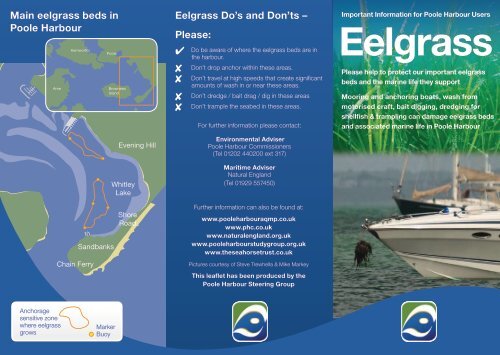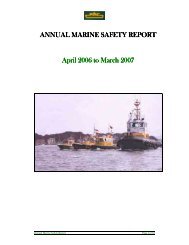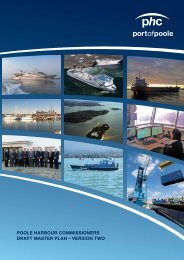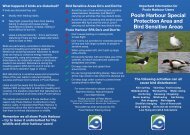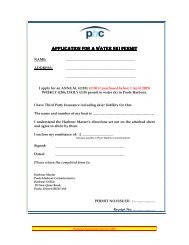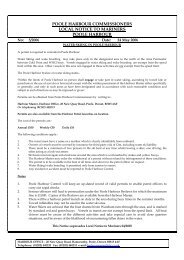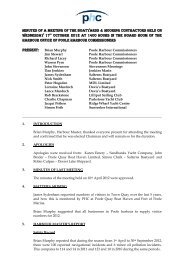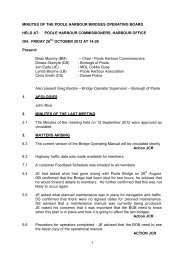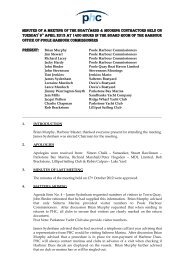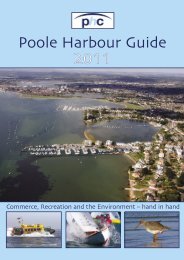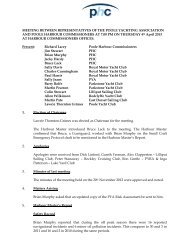Eelgrass Leaflet - Poole Harbour Aquatic Management Plan
Eelgrass Leaflet - Poole Harbour Aquatic Management Plan
Eelgrass Leaflet - Poole Harbour Aquatic Management Plan
Create successful ePaper yourself
Turn your PDF publications into a flip-book with our unique Google optimized e-Paper software.
Main eelgrass beds in<br />
<strong>Poole</strong> <strong>Harbour</strong><br />
Arne<br />
Hamworthy<br />
<strong>Poole</strong><br />
Brownsea<br />
Island<br />
Evening Hill<br />
Whitley<br />
Lake<br />
<strong>Eelgrass</strong> Do’s and Don’ts –<br />
Please:<br />
✔<br />
✘<br />
✘<br />
✘<br />
✘<br />
Do be aware of where the eelgrass beds are in<br />
the harbour.<br />
Don’t drop anchor within these areas.<br />
Don’t travel at high speeds that create significant<br />
amounts of wash in or near these areas.<br />
Don’t dredge / bait drag / dig in these areas<br />
Don’t trample the seabed in these areas.<br />
For further information please contact:<br />
Environmental Adviser<br />
<strong>Poole</strong> <strong>Harbour</strong> Commissioners<br />
(Tel 01202 440200 ext 317)<br />
Maritime Adviser<br />
Natural England<br />
(Tel 01929 557450)<br />
Important Information for <strong>Poole</strong> <strong>Harbour</strong> Users<br />
<strong>Eelgrass</strong><br />
Please help to protect our important eelgrass<br />
beds and the marine life they support<br />
Mooring and anchoring boats, wash from<br />
motorised craft, bait digging, dredging for<br />
shellfish & trampling can damage eelgrass beds<br />
and associated marine life in <strong>Poole</strong> <strong>Harbour</strong><br />
Chain Ferry<br />
Sandbanks<br />
Shore<br />
Road<br />
Further information can also be found at:<br />
www.pooleharbouraqmp.co.uk<br />
www.phc.co.uk<br />
www.naturalengland.org.uk<br />
www.pooleharbourstudygroup.org.uk<br />
www.theseahorsetrust.co.uk<br />
Pictures courtesy of Steve Trewhella & Mike Markey<br />
This leaflet has been produced by the<br />
<strong>Poole</strong> <strong>Harbour</strong> Steering Group<br />
Anchorage<br />
sensitive zone<br />
where eelgrass<br />
grows<br />
Marker<br />
Buoy
<strong>Poole</strong> <strong>Harbour</strong><br />
<strong>Poole</strong> <strong>Harbour</strong> is one of the largest estuaries in Britain<br />
with an enclosed, lagoonal character. The diversity of<br />
habitats and species that it holds have led to it being<br />
designated as: a Site of Special Scientific Interest (SSSI)<br />
under the Wildlife and Countryside Act (1981), a Special<br />
Protection Area (SPA) under the EC Birds Directive,<br />
and a Wetland of International Importance under the<br />
Ramsar convention.<br />
In the summer, <strong>Poole</strong> <strong>Harbour</strong> holds nationally<br />
important breeding populations of common tern,<br />
black-headed gull and Mediterranean gull. Between<br />
September and March <strong>Poole</strong> <strong>Harbour</strong> is home to<br />
internationally important numbers of avocet and blacktailed<br />
godwit and a total of over 20,000 wading birds<br />
and waterfowl. It is also the home of a busy commercial<br />
port and is utilised by a diverse array of user groups<br />
including yachtsmen, fishermen, and windsurfers.<br />
There is a need to integrate the legitimate interests of<br />
all user groups with the need to secure the wellbeing<br />
of the harbour environment and the bird populations<br />
it supports. In recognition of this, the <strong>Poole</strong> <strong>Harbour</strong><br />
Steering Group re-published the <strong>Aquatic</strong> <strong>Management</strong><br />
<strong>Plan</strong> in 2006. One of the issues that it identified was<br />
the need to protect beds of eelgrass from damaging<br />
activities.<br />
<strong>Eelgrass</strong> biology<br />
<strong>Eelgrass</strong>es, although they grow in the sea, are not<br />
seaweeds. They are flowering plants. There are three<br />
species of eelgrass in the UK: common eelgrass<br />
Zostera marina, narrow-leaved eelgrass Z. angustifolia<br />
and dwarf eelgrass Z. noltii. <strong>Plan</strong>ts of all species<br />
consist of tubers and roots buried in the sediment and<br />
strap-like green leaves which stand up in the water.<br />
Common eelgrass typically grows in shallow inshore<br />
areas that are permanently covered by seawater.<br />
Narrow-leaved and dwarf eelgrass grow in intertidal<br />
areas exposed to the air when the tide goes out.<br />
All species often form extensive ‘meadows’.<br />
<strong>Eelgrass</strong> meadows are highly productive, stabilize the<br />
sediment and provide a sheltered habitat that supports<br />
a large number and wide diversity of marine organisms<br />
including many invertebrate species, cuttlefish and fish<br />
including pipe fish, wrasse and gobies. <strong>Eelgrass</strong> beds<br />
within <strong>Poole</strong> <strong>Harbour</strong> provide an important habitat<br />
for both spiny and short-snouted seahorses. Both<br />
species of seahorse are now listed on Schedule 5 of<br />
the Wildlife and Countryside Act (1981) and are given<br />
Brent geese eating eelgrass<br />
general protection under section 9 of the Act. It is an<br />
offence to intentionally or recklessly cause damage to<br />
or destroy any structure or place which seahorses use<br />
for shelter or protection. <strong>Eelgrass</strong> is also an important<br />
food resource for wintering wildfowl, which form part of<br />
the interest of the site, including brent geese, wigeon<br />
and mute swans.<br />
Threats to eelgrass from<br />
disturbance<br />
<strong>Eelgrass</strong>es are not physically robust. Their leaves and<br />
roots are easily damaged, and seeds can be buried<br />
too deeply to germinate by activities such as trampling,<br />
anchoring, digging, shellfish dredging and by wash<br />
from power boats and personal watercraft. Physical<br />
disturbance can lead to increased patchiness and<br />
destabilization of the eelgrass bed, which in turn can<br />
lead to reduced sedimentation within the eelgrass bed,<br />
increased erosion, and loss of larger areas.<br />
Whilst eelgrass beds may persist in areas where<br />
disturbing activities occur, they may not be as healthy<br />
or as extensive as they might be.<br />
Helping to protect eelgrass in<br />
<strong>Poole</strong> <strong>Harbour</strong><br />
<strong>Eelgrass</strong> within <strong>Poole</strong> <strong>Harbour</strong> is restricted to two<br />
main beds in the Whitley Lake area (see map). Both<br />
of these areas were identified in the <strong>Poole</strong> <strong>Harbour</strong><br />
<strong>Aquatic</strong> <strong>Management</strong> <strong>Plan</strong> as ‘anchorage sensitive<br />
zones’ and they are now marked with buoys. <strong>Poole</strong><br />
<strong>Harbour</strong> Commissioners Moorings Policy 2008 aims<br />
to phase out moorings in these environmentally<br />
sensitive areas. In the meantime, everyone can help<br />
to protect eelgrass beds and the rich plant and animal<br />
communities that they support by following the simple<br />
guidelines overleaf.<br />
Spiny seahorse. Body up to 15cm.


